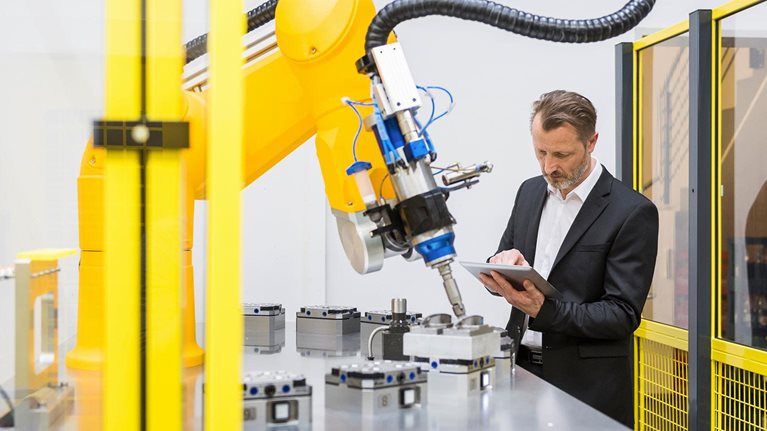Twenty kilometers outside of central Beijing sits the sprawling headquarters of China Mengniu Dairy, China’s second-largest dairy company. It might not boast the same glossy exterior as China’s colossal technology companies’ campuses, and CEO Jeffrey, Minfang Lu admits that the dairy industry suffers from a less-than-innovative image, but behind modest doors lies a rapidly modernizing business.
Armed with more data than its people can currently compute, Mengniu Dairy is embarking on an effort to bring the centuries-old industry up to date through the use of artificial intelligence (AI) in China and beyond. As it does, the company hopes to innovate across everything from manufacturing and supply chains to product development and marketing.
As with everything in China, the scale of the ambition is huge. Each year, the company sells 12 billion packets of product, chiefly milk and yogurt products, which are produced across 58 manufacturing sites and more than 1,000 manufacturing lines in China. In addition to the impressive scale of production, the company has access to 20 million “active” consumers who share information about their product preferences and lifestyle habits through e-commerce and social channels. Mengniu Dairy’s product-development, forecasting, manufacturing, and marketing teams interpret these data, albeit not fast enough.
By tapping into consumer trends that extend beyond the immediate product, Mengniu Dairy hopes to make milk and yogurt more appealing among a younger, savvier Chinese consumer. A recent, and notable, example saw milk products featured in a kung fu film alongside Alibaba CEO Jack Ma and kung fu star Jet Li. China is in the midst of a transition from a country of people who do not drink much milk and have perceptions of lactose intolerance to one where consumption catches up with the research showing that 80 percent of Chinese people can drink 200 milliliters of milk at a meal without adverse reaction. Plans are afoot to expand Mengniu Dairy’s physical footprint, too, beyond China’s borders and into Southeast Asia to capitalize on the government’s Belt and Road Initiative.
In December 2017, Mr. Lu sat down with McKinsey Quarterly to share more about the company’s digital-transformation plan and how he hopes technology can help its leaders better understand ever-changing Chinese consumption habits.
The Quarterly: How are some of the well-documented changing consumer habits shaping your business?
Mr. Lu: One of the big changes is that consumers are more mobile than before. People are on the move, they are traveling, and they have a mobile phone wherever they go. We need to really take this seriously and see how it will impact our model, and our route to market, and the way we communicate with customers. In the past, you will see consumers go to a supermarket, buy enough stock for one month, and go back each month, and your job is done. This is no longer going to happen. Consumers have more choice. They can go to a small convenience store; they can use their mobile apps and have a product delivered to their home.
The Quarterly: How are you using digital technology to tap into the changing consumer behavior?
Mr. Lu: The new environment is all about data. If you look at our industry, you will see a very long supply chain all the way from grass to glass. You can collect data from farms and even from individual cows. When you go into the supply-chain side and into manufacturing, you have much more data. When you look at our logistics, we have a huge amount of milk, which is transported across the nation. And then, on the consumer side, you see consumers buying our products online, communicating with us online—and so there is a lot of consumer transactional and interaction data.
Across our entire chain of our business, data is available for us to translate into knowledge about our business. But it’s all about how to use this data to empower our decision making across our business activities.
More and more, this is about using AI to help us to improve our ability to do further analysis. Our capability to calculate and to analyze this data relies on us using the newest knowledge.
Just for example, at Mengniu, we collect four million tons of milk each year. We sell 12 billion packs of product to our consumer, and we have 58 manufacturing sites, more than 1,000 manufacturing lines, more than 2,000 SKUs. If you put everything together, honestly, humans cannot do this analysis anymore.
So today, we have kicked off some big projects—with Alibaba, for example—to use AI to analyze our supply chain, to tell us where we should manufacture products, to tell us where we should collect the milk, and to tell us how we can transport these products to our customers so that we get the maximum efficiency out of all this data.
The Quarterly: That is a great example of how data are helping you tackle productivity challenges internally. Can you talk about any other initiatives that will help you better understand your customers?
Mr. Lu: On the consumer side, we built an internal capability to get the consumer data out of a huge database. We have 20 million consumers who are actively talking to us in our data bank monthly. We know exactly who they are, how they behave, and how they interact with us, and we use this to adjust our product and adjust our formulation in order to meet their needs.
At the same time, consumers are also able to get access to more of the services and products that we are offering, either through an online channel or through membership interaction or through a microcommunity.
So again, this gives a lot more transparency over how we run our business. We can forecast for the next day instead of a month later. And we can read consumer trends—whether they like more sugar, less sugar. They may also tell us where they go in terms of what entertainment programs, dramas, and movies they are watching. This provides a lot of possibility for us to get the access to our consumer but also to give our consumer the ability to access us.

Double-clicking on the Chinese consumer
The Quarterly: How do you see the changes you have been describing playing out over the next few years?
Mr. Lu: We need to see how we can use these changes in the market to actively engage with our consumers, to provide personalized, individualized products for the young and old, because they all have different needs.
For example, we are working on how to get our product to be more interesting and to have a different taste profile that appeals to a younger audience. How can we give consumers much more than nutrition? We need to give them enjoyment. We need to give them excitement.
We also want to work on the image of Mengniu, to become younger looking and more fashionable. We cannot blame consumers for not liking milk or our packaging. If we do these two things right, then I think we will be part of a consumer’s healthy enjoyment of life rather than just a pack of milk sitting in the fridge.
The Quarterly: If China’s bold Belt and Road Initiative does indeed open the borders to increased outbound and inbound trade, what is the opportunity for Mengniu Dairy to become a global brand?
Mr. Lu: Now, honestly, Mengniu is still very much a Chinese company. But whereas in the past, the Chinese government or Chinese companies were very good in terms of exporting machine equipment and infrastructure capabilities, today we find, given the One Belt, One Road strategy, there is opportunity for a consumer-goods company like us. We are expanding into markets like Hong Kong, Macau, Singapore, Malaysia, Myanmar, and Bangladesh; we find huge opportunity in these markets.
For example, I was in Indonesia recently. It’s amazing because in Jakarta, an area of 15 million people, we know the consumers and they like our product. If we take our product there, we will find out that there are a lot of similar products and that they have the same preference [as Chinese consumers]. We have tested two products in this market and got very, very good feedback.
It also gives us opportunities to expand our products. In Southeast Asia, ice cream is a very important category because, unlike China, you have no seasonality. You can eat ice cream every day. And the same thing for the fresh dairy products. Some of these markets are like China 20 years ago, like in Myanmar and Bangladesh. We understand the consumer and the category trends as well as the country trends.
With One Belt, One Road, there is support from the local countries that are more open to a Chinese company running business there. Alibaba is there. We can see Jingdong is there. We can see also Xiaomi and Vivo—they are all there. This is a different ecosystem today than in the past.
The Quarterly: Can you explain the motivation behind your recent film collaboration with Alibaba and Jack Ma?
Mr. Lu: It was interesting because the motivation for the film came from Alibaba—and from Jack Ma, who wanted to change the impression of kung fu to make it fun, interesting, and part of modern Chinese culture and bring it to the front of the consumer mind. This was the purpose of the film, and that also resonates with what we at Mengniu want to do as well. We are not just a milk manufacturer telling you what we can do; we want to be part of your life.



